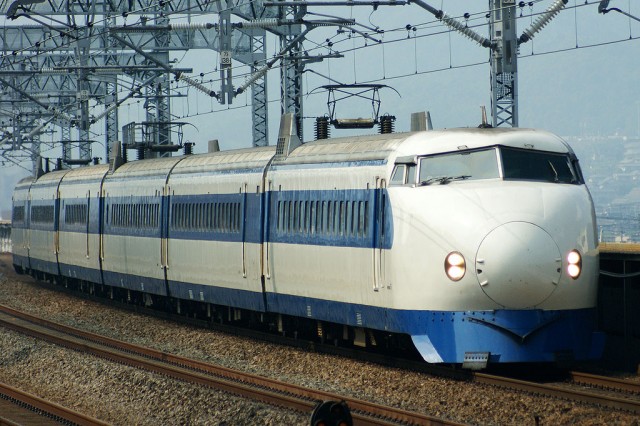
Don’t worry, you’re at the right place. As JNC fans, sometimes we find ourselves fascinated by various vintage Japanese machines and the Shinkansen, or bullet train, is perhaps the most historically and culturally significant. The image of sleek white arrow piercing the landscape with a snow-capped Mt. Fuji in the background is a veritable Japanese icon, and on this very day 50 years ago — October 1, 1964 — the famous train took its maiden voyage. Today, we take a look at the Shinkansen, especially the original “0 Series” model. It has more than four wheels and doesn’t fit in your garage, but it’s a true Japanese classic.

High-speed rail was contemplated in Japan as early as the 1930s, when the term dangan ressha (bullet train) originated. The word shinkansen (new trunk line) — denoting a new main line throughout Japan — came a decade later as the Japanese Ministry of Railways formalized the plan for high-speed rail capable of reaching 120 mph. Perhaps reflecting a more ominous page in history, the network was originally planned to reach mainland Asia via a tunnel to Korea and onward to Beijing, the Trans-Siberian Railway, and even as far south as Singapore.
Obviously, this never came to be. During Japan’s post-war reconstruction, its industrial and economic growths led to a boom in train ridership, so much so that the Tokaido Main Line — Japan’s busiest railway, connecting Tokyo and Kobe — was operating at full capacity by the mid-1950s. The country was in need of a rail upgrade.
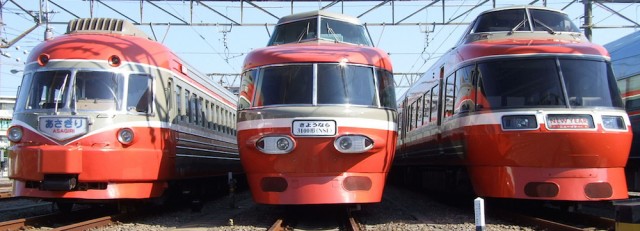
Japan’s first high-speed train came in 1957, the Odakyu Electric Railway’s 3000 Series Super Express ”Romancecar,” a special line providing luxury tourist service from Tokyo to various vacation spots. At the time, maximum speed of Japanese trains hovered around 60 mph, but upon debut the 3000 SE instantly set a world speed record for narrow-gauge trains at 90 mph.
The distinctive, aerodynamic red train, along with its immediate successor the 3100 Series, were actually quite iconic themselves. The Japan Railfan Club (JRC) bestowed its inaugural Blue Ribbon Award for train design upon the 3000 SE in 1958, and the line stayed in service all the way until 1991. Its greatest legacy, however, is its speed record, providing the momentum and conviction to develop the full-on high-speed rail system and serving as the “root of the Shinkansen.”
 The 1950s also marked the beginning of the jet age. The first passenger jetliner, the De Havilland Comet, entered service in 1952. In 1958 the Boeing 707 became the first commercially successful jetliner and the first plane to carry more passengers across the Atlantic by air than by ship. In the US, domestic flights grew ever more popular, practical, and convenient, leading many to speculate that flying would soon render the railway obsolete.
The 1950s also marked the beginning of the jet age. The first passenger jetliner, the De Havilland Comet, entered service in 1952. In 1958 the Boeing 707 became the first commercially successful jetliner and the first plane to carry more passengers across the Atlantic by air than by ship. In the US, domestic flights grew ever more popular, practical, and convenient, leading many to speculate that flying would soon render the railway obsolete.
However, Shinji Sogo, president of Japan National Railways (JNR), steadfastly believed in high-speed rail for Japan. He lobbied hard for political support for the Shinkansen, won, and began construction in 1959. An ambitious and expensive project, the Shinkansen encountered vociferous opposition from both inside and outside of JNR. Many considered it a farce. To ensure completion of the project, Sogo cleverly secured funding from the World Bank that effectively locked the Japanese government into Shinkansen construction.
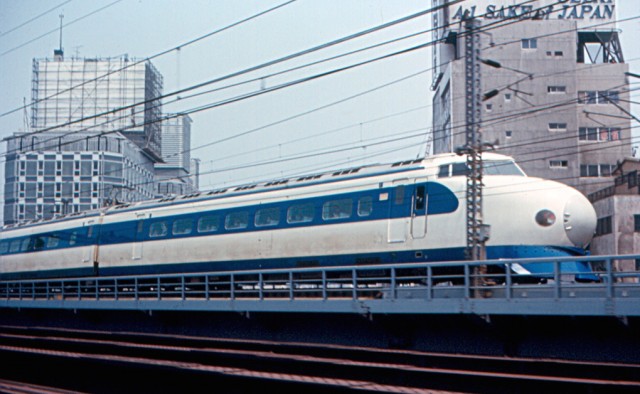
The Tokaido Shinkansen was to be the first leg, linking Tokyo and Osaka, Japan’s two largest metropolitan areas. The Tokaido itself refers to ancient Japan’s most famous road, connecting the capital Kyoto with the port city of Edo (present-day Tokyo) by way of the country’s southern coast. There are expressways that follow the old route as well, which we featured in a Grand Touring piece a couple of years ago.
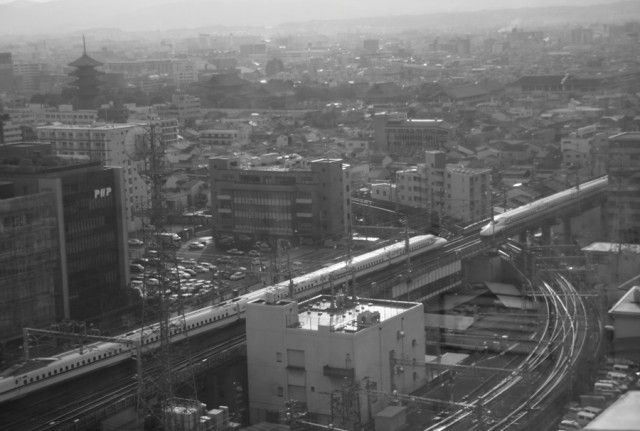
Japan’s railways consisted of only narrow gauge tracks at this time, some of which meandered around mountains. Track gauge (the width between rails) is an important metric among locomotive engineers and enthusiasts. Aside from compatibility, it influences characteristics such as speed and capacity. A variety of gauges exists around the world stemming from both legacy and need, but in Japan early railway systems were built using the narrow gauge partly to overcome challenges posed by the mountainous terrain there. However, the narrow-gauge and abundant curves hampered speed and upgradability.
This predicament led to one of the unique achievements of the Shinkansen: it was the first high-speed train in the world to have its own dedicated rail system. Despite experimentation with existing tracks to adapt them for dual narrow- and standard-gauge use, it was decided that Shinkansen trains would ride on standard-gauge tracks not shared with slower conventional trains.
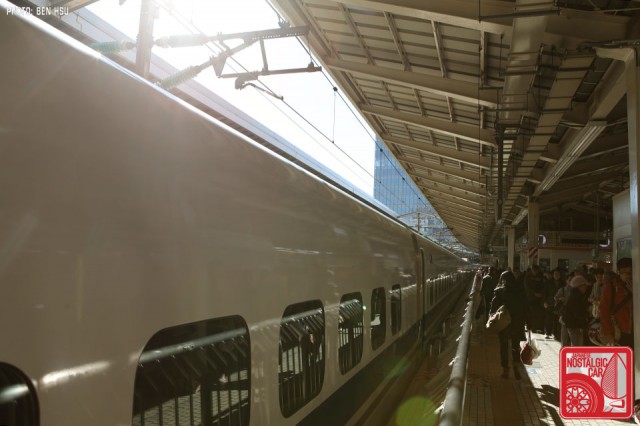
This gave planners freedom to route tracks across obstacles as directly as possible using tunnels and bridges, avoiding curves and thereby maximizing speed. Furthermore, there are no traffic or pedestrian crossings for the Shinkansen, and the tracks are strictly isolated from and off-limits to the public, making it largely unaffected by slower traffic.
Like the Odakyu 3000 SE, Shinkansen trains are “electric multiple units,” meaning each car provides propulsion to the whole train. This maximizes both acceleration and deceleration and thus average speed. It is capable of such high speeds that sonic booms are created when they exit tunnels, and the cars are air-sealed to maintain stable pressure.
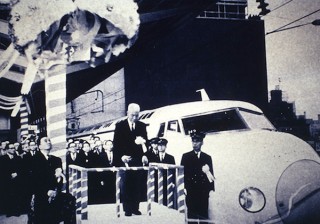 The Tokaido Shinkansen began operation on October 1, 1964, nine days before the Tokyo Summer Olympics. The first running of the trains, “Hikari #1” from Tokyo and “Hikari #2” from Osaka, reached 130 mph. This shortened the trip from 6 hours and 40 minutes to 4 fours flat. Speed increased to 137 mph the next year, shortening the trip by almost another hour.
The Tokaido Shinkansen began operation on October 1, 1964, nine days before the Tokyo Summer Olympics. The first running of the trains, “Hikari #1” from Tokyo and “Hikari #2” from Osaka, reached 130 mph. This shortened the trip from 6 hours and 40 minutes to 4 fours flat. Speed increased to 137 mph the next year, shortening the trip by almost another hour.
Not only did the new bullet train gain international attention for Japan, domestically it was an instant success. Within 3 years, the Shinkansen had served 100 million passengers! Critics immediately became converts, and expansion of the system quickly began, first westward to Hiroshima and Fukuoka. By 1976, the train had carried over a billion passengers. Today, the Tokaido Shinkansen is the busiest high-speed rail corridor in the world, carrying around 150 million passengers a year.

In total, it’s carried over 5.3 billion passengers and contributes to about half of the ridership of the entire Shinkansen system. Up to 13 trains per hour, each seating over 1,300 passengers, run in each direction between Tokyo and Osaka.
Yet for such a high-volume system, the Shinkansen has an amazing safety record: zero passenger fatalities due to collision or derailment. The only (non-suicide-related) fatality was due to a door-closing incident. Also remarkable is its reliability and timeliness, with the average delay under 40 seconds. The least late year on record, however, was 1997 at an average delay of just 18 seconds. These numbers are both impressive and mind-boggling.

The original Shinkansen train type was the venerable “0 Series.” For those who grew up in or before the 1980s, this is likely the archetypal bullet train in your minds. When first introduced in 1964, these trains were painted in the iconic white with blue stripes running along the windows and undersides of the body. You may also recall these trains painted with green instead of blue stripes; these were the 0 Series trains running on the Tohoku Shinkansen, connecting Tokyo northward to Aomori Prefecture.
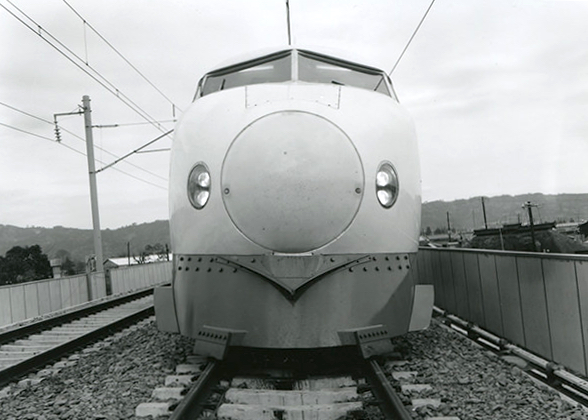
The design of the 0 Series end cars (the “head” of the train) resembled that of contemporary aircraft. The front was tapered with a round nose cone, flanked by two large round headlights, with the cockpit windshields sitting high above the nose. The pilot (or cow catcher) was an integral part of the blue-painted underside, resembling a massive wind splitter and contributing to the train’s sleek, space age appearance. To top it off, there was a small fin just above the cockpit.
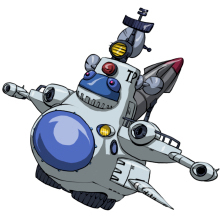 It may have been designed to
achieve optimum aerodynamics (hence its jumbo jet-like appearance),
but nowadays it looks like
something out of a retro sci-fi
movie. In fact, Doraemon fans may find
some semblance of the 0 Series Shinkansen in the Time Patrol
ship. And images of the 0 Series traveling just above street level through Japan’s hybrid urban and traditional cityscapes might as well be scenes out of a steampunk fantasy.
It may have been designed to
achieve optimum aerodynamics (hence its jumbo jet-like appearance),
but nowadays it looks like
something out of a retro sci-fi
movie. In fact, Doraemon fans may find
some semblance of the 0 Series Shinkansen in the Time Patrol
ship. And images of the 0 Series traveling just above street level through Japan’s hybrid urban and traditional cityscapes might as well be scenes out of a steampunk fantasy.
As electric multiple units, every car of a 0 Series train was powered by electric motors at each axle. The original trains consisted of 12 cars but this was later expanded to 16. The 16- car trains, capable of carrying up to 1,340 passengers, stretched out over a quarter-mile long!

From 1963 to 1986, over 3,200 0 Series Shinkansen were produced by manufacturers such as Hitachi, Kawasaki, and Nippon Sharyo. The 0 Series saw mechanical and livery upgrades over the years, and later iterations had maximum speed increased to 140 mph. In 1984, the 0 Series (which up to that point did not have such designation) was joined by the 100 Series. A much sleeker and more modern-looking train, the 100 Series had a pointier nose and faster taper, with the round headlights replaced with thin slits.
Today, there’s a dizzying array of Shinkansen train types serving different regions, most of them bearing little or no resemblance to the 0 Series. Current maximum speeds reach as high as 200 mph in service, with speed records topping 275 mph. But for 20 years the 0 Series soldiered on alone while overseeing a period when Japan underwent incredible economic and industrial growth.
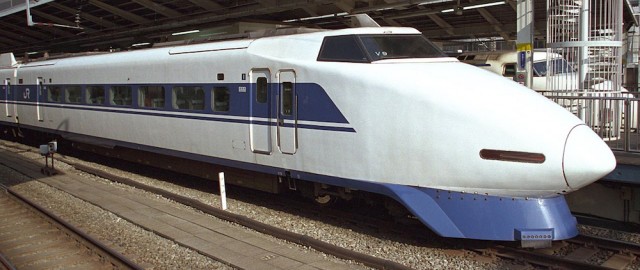
The Shinkansen’s cultural impact has been enormous, serving as a cultural ambassador for Japan as well as a national symbol domestically. Like its spiritual predecessor, the 0 Series promptly won JRC’s Blue Ribbon Award in 1965. During a 1964 test run — a televised event with much fanfare — the 0 Series famously outran the NHK (Japan Broadcasting Corporation) news helicopters and blew the socks off spectators on location and in front of the television.

Not only did Shinkansen signify progress and technical capability for post-war Japan, it transformed Japanese society. By shortening the travel time between Tokyo and Osaka to 3 hours, day trips became not just possible, but convenient. This dramatically impacted business practices during Japan’s “income-doubling” economic growth spurt. As a result, its iconic status surpasses that of the TGV or Eurostar and can be likened more to that of the Concorde jetliner.
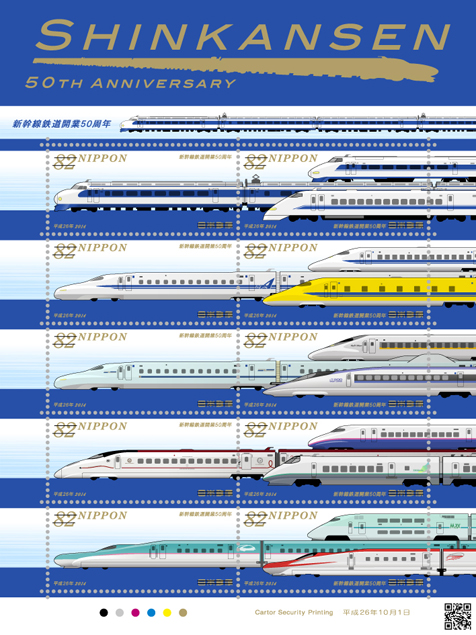 In addition to Mt. Fuji imagery, the Shinkansen has graced a number of postage stamps in Japan. The latest design was issued today by Japan Post to commemorate the 50th anniversary. Later this month, NHK is also launching a television drama called Shinkansen Wives, depicting the personal lives of the original Shinkansen developers and looks to be in the best dramatic television tradition of Asia.
In addition to Mt. Fuji imagery, the Shinkansen has graced a number of postage stamps in Japan. The latest design was issued today by Japan Post to commemorate the 50th anniversary. Later this month, NHK is also launching a television drama called Shinkansen Wives, depicting the personal lives of the original Shinkansen developers and looks to be in the best dramatic television tradition of Asia.

Toys and models recreating the Shinkansen abound in Japan. Sanrio might equate to Hello Kitty for most of us, but Shinkansen goods are actually one of its principal Japanese products. As you may imagine, the range is extensive, from stationary to lunchware, and they occupy as much shelf space in Japan as Hello Kitty herself. The most popular character of the lineup? The 0 Series, naturally.

As a machine, the Shinkansen trains are among the most impressive and advanced produced by Japan. The original 0 Series has aged like a classic car, looking fabulously nostalgic. Next time you’re in Japan, chances are that you’ll take advantage of the Shinkansen to aid your travels. Why not go a step further and visit one of the preserved 0 Series trains? A few museums, such as Osaka’ Modern Transportation Museum and Saitama’s Railway Museum, even have the original units built in 1964. Incidentally, the National Railway Museum in York, UK is one of the few western ones to house a 0 Series in its collection.
Happy Birthday, Shinkansen!
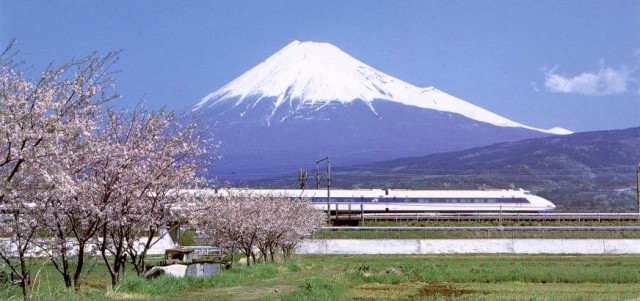
Images: spaceaero2, Roger Wollstadt, tonko43, Toshihiro Oimatsu used under Creative Commons license; Doraemon Time Patrol ship illustration: HiroDango.






There is nothing quite like sitting down with a cold can of beer, a packet of wet ika, and feeling the continual push in the back as you accelerate out of Tokyo, watching the countryside pass you by… One of life’s great pleasures.
The Zero-kei always had that little extra bit of romance… Neko.
this is a shopping mall now
jklol
As Neko said, there’s nothing like riding a Bullet Train. I’ll never forget our first trip to Japan, where we planned to stay in Osaka for the first half and Tokyo for the second half. This necessitated sleepless non-stop traveling for well over 24 hours (RNO to LAX to NRT to Shinjuku Station via the Narita Express and then onward to Osaka via Shinkansen). By the time we settled in for the three hour train ride from Tokyo to Osaka via Bullet Train, we were weary and dizzy with fatigue, albeit high on life and full of excitement from just being in Japan. A bento box and some o-sake is all it took to begin to doze off in the comfortable seats, only to be startled awake by a passing train on the adjacent rail. The WOOSH! is more than just a sound. You can feel the pressure of the passing train generated by the intense speed at which you are going. A truly awesome experience, and one NOT to be missed if you plan to stay in Japan for any length of time. Shinkansen rides are not cheap, but they are worth every penny. The level of comfort, cleanliness and convenience is unlike any public transportation you are likely to experience. And let’s not forget the massive train stations in Osaka and especially Tokyo. These are sites to behold, and difficult to fully describe to those who have not experienced it first-hand. I think the Shinkensen is an icon of Japan for sure. It encapsulates the culture of convenience, cleanliness and service that makes Japan a first class experience all around. Great article, and a fantastic choice of pictures as well! 😉
PS – I bought a small model Shinkansen for my dad (who collects N-gauge trains) while in Akihabara. Upon leaving Japan, going through security, my bag caught some attention as it passed through the x-ray machine. I was taken aside and my bag was gently torn apart by airport personnel. The item that caused suspicion was of course the small toy Shinkansen train still in its unopened box. I found this amusing.
At the risk of being labelled anally retentive, Edo was the Shogunate name for Tokyo, not Kyoto.
Thanks, noted!
Please note that the Modern Transportation Museum in Osaka has closed. It will reopen at a different location in 2016. The SCMaglev and Railway Park is nearby in Nagoya and has the biggest collection of 0-series cars anywhere.
Great article and great site.
Thanks for the note!
Another train museum to visit is in Nagoya – the SCMAGLEV and Railway Park.
Japanese – http://museum.jr-central.co.jp/
English – http://museum.jr-central.co.jp/en/
I visited 2 years ago and I’d recommend it to anyone interested in trains and transportation history. We were there on my birthday, and I’ll never forget when they blew the horn on the Series-0 Shinkansen.
That sounds awesome. Did they blow it especially for your birthday?
LOL, I like to think so, but I doubt it. 😉
As originally conceived, the Shinkansen locomotives were equipped with a radar transponder which coupled to an open “Y” shaped [vertical leg up to couple with the trackside mating open antenna / waveguide alongside the tracks.] One of the above photos seems to show the boxlike housing on the locomotive. The radar frequency and power were sized to detect a human or cow that had wandered too close to the new tracks, pending a completely “sealed” trackage like the interstate roadways. The crossties [AKA sleepers] were concrete assemblages like those in Great Britain. Above info based on a series of articles in the journal of the AIEE [American Institute of Electrical Engineers]. The tunnels through the mountains were about triple the cross section area of the existing tunnels to dissipate the air pressue buildup in front of the locomotive and to disipate the sonic blast as the train entered and exited the tunnel. Later model added streamlining grooves and planes to add to the displacement phonomena thus increasing the top speed through the tunnels and cutting travel times.
I relooked at the picture. Those are indeed the transmit and receive antenna housings, and if you look closely you can see the waveguides on both sided of the track.
That’s very cool. Is this common/standard equipment on high-speed trains by now?
No mention of Doctor Yellow? You heinous folks!!
https://en.wikipedia.org/wiki/Doctor_Yellow
I’m still looking for an image of the 0 Series Shinkansen crossing the Fuji River Bridge (west of Shin-Fuji Station) with a snow-capped Mount Fuji in the background. I believe JNTO produced posters with such an image during the 1960’s and 1970’s as great way to promote tourism to Japan, a nod to its historical past and showcasing the latest in Japanese technology.
Wow dig it!
One single day younger than Me! How did I miss that birthday?
Years ago I built a brass tube frame HO scale Bullet train with a hot Champion Slot Car motor.